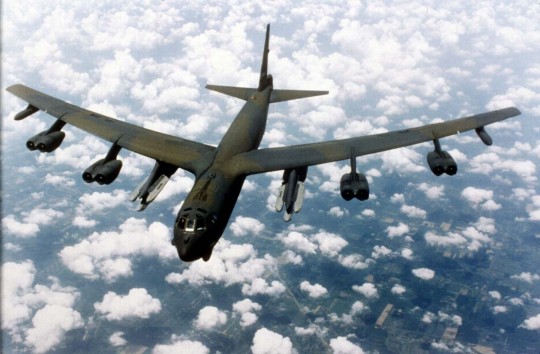Three nuclear-capable bombers deployed to Europe this week for large-scale military exercises near Russia, the Strategic Command announced Friday night.
The B-52s from Minot Air Force Base, North Dakota, are currently operating from a base in Britain and joined maritime naval exercises in the Baltic Sea called Baltops 15, the largest naval exercise by NATO forces in the region this year.
The exercises are being held on and above international waters in the Baltic Sea and in Latvia, Lithuania, and Estonia—the Baltic states—and Poland.
All four nations fear Russia’s military aggression in Crimea and continuing destabilization in eastern Ukraine will be followed by Moscow’s use of military force against them.
The Baltic states last month asked NATO to permanently deploy up to 5,000 troops to the region to deter Russian aggression. Poland also wants a permanent NATO military presence.
Russian generals told U.S. officials in March during a meeting in Germany that Russia would take destabilizing actions against the Baltic states if NATO troops are stationed there.
Russia threatened to conduct a "spectrum of responses from nuclear to non-military," the Times of London reported, quoting a participant at the meeting.
The Russian generals compared the situation in the Baltics to the conditions in Ukraine prior to the annexation of Crimea.
The U.S. bomber deployment to Europe also comes amid a sharp increase in Russian long-range bomber flights in both Europe and North America, including close flights within U.S. and Canadian air defense zones in recent months.
The bombers also will take part in an international U.S. Army Europe-led exercise called Saber Strike. That exercise aims to boost cooperation and war-fighting capabilities of regional allies for future contingency operations.
Baltops 15 will include practicing mine clearing, anti-submarine warfare, and surface-to-air defenses. Other activities include counter-piracy and small boat operations.
For Saber Strike, the bombers will take part in air intercept training for regional air forces, simulated mining operations, inert bomb drops and close air support.
"The deployment demonstrates the United States’ ability to project its flexible, long-range global strike capability and provides opportunities to synchronize strategic activities and capabilities with allies and partners in the U.S. European Command (USEUCOM) area of operations during the month of June," Stratcom said in a statement announcing the deployment.
A senior NATO general warned last week that Russian military forces could overrun the Baltic States in two days, and the West would be unable to halt the aggression.
"From a technical point of view, if I consider how many forces Russia is able to deploy in the Baltics when compared to the size of the Baltic countries and the density of their forces, it means that they could really be occupied in a couple of days," said Czech Gen. Petr Pavel, who will soon take over as head of NATO’s military committee. His remarks were reported May 28 in the Scotsman newspaper.
The combined forces of the Baltic States total around 13,000 troops. Russia’s military has an estimated 800,000 troops.
Baltops began Saturday and will continue through June 21 with warships and other forces from 12 countries and NATO allies.
"Our continued presence, as an international force, is a clear demonstration of our commitment to regional stability and to each other," said Rear Adm. Richard Snyder, Baltops 2014 commander. "Here, we send a signal to our nations and to the world that we can come together and operate as a team."
A Russian submarine was recently detected inside Swedish waters, raising new concerns about Moscow’s aggressive military posture following the military annexation of Ukraine’s Crimea last year.
Military forces from the United States, Denmark, Estonia, Finland, France, Georgia, Germany, Latvia, Lithuania, the Netherlands, Poland, Sweden, and the United Kingdom are taking part in Baltops 15.
In addition to the increase in nuclear bomber flights, Russia has been making nuclear threats against NATO and has held large-scale nuclear war games. The activities have raised new concerns about future Russian nuclear strikes.
"This deployment to RAF Fairford was specifically designed and closely coordinated with the United Kingdom and our regional Allies to ensure maximum opportunities to synchronize and integrate our bomber capabilities with their military assets," said Navy Adm. Cecil D. Haney, Strategic Command commander.
"Participation of B-52s in Exercises Baltops and Saber Strike demonstrates our nation’s steadfast commitment to promoting regional stability and security, fostering cooperation and increasing interoperability as we work alongside our allies toward mutual goals."
Lt. Col. Bradley Dyer, 23rd Expeditionary Bomb Squadron commander who is in charge of the bombers, said the deployment seeks to bolster support for regional allies.
"Our partnership with the countries out here in U.S. Air Forces in Europe and Air Forces Africa is significant," he said. "We need their support, and we want to assure them they have our support as well for any kind of conflicts that may arise in the future—our relationship with them is key."
"The significance of us participating with our [allies] and the importance of why we participate with them is to show them we can project bomber capability into the European theater at any time," Dyer said.
Other recent B-52 missions were held during military exercises in Jordan in May, when two bombers flew non-stop simulated bombing flights.
In April, four B-52s flew round-trip flights to the Arctic and North Sea regions as part of a training mission called Polar Growl that involved British fighter aircraft conducting practice aerial intercepts.
Stratcom also dispatched bombers in October to Spain for participation in NATO’s maritime response forces.
